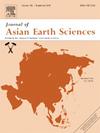Deciphering Sb–Au mineralization event in the Longshan deposit, South China: Linking sulfide geochemistry and hydrothermal alteration
IF 2.7
3区 地球科学
Q2 GEOSCIENCES, MULTIDISCIPLINARY
引用次数: 0
Abstract
The Longshan is one slate-hosted Sb–Au deposit located in the Jiangnan orogenic belt, South China. It features two sets of mineralized quartz veins, striking in NE and NW directions, respectively. It remains unclear whether these veins are the products of one or two Au–Sb mineralizing event (s). In this study, geological investigation, TESCAN Integrated Mineral Analyzer (TIMA), coupled with high sensitivity laser ablation inductively coupled plasma mass spectrometry (LA–ICP–MS) trace elements analyses of pyrite and arsenopyrite were performed to reveal the sulfides (pyrite and arsenopyrite) geochemistry, paragenesis and types of hydrothermal alteration. These results indicate that wallrock hydrothermal alteration is intensive for both vein sets, with the main alteration types being silicification, sericitization, sulfidation, and carbonatization. Detailed texture investigations show that there is an insignificant difference between these two sets of quartz veins, as zoning texture is well-developed for pyrite whereas arsenopyrite shows weak inhomogeneity. LA–ICP–MS trace elements concentrations also display similar ranges such as Au and Sb for both pyrite and arsenopyrite from both sets of veins. Complemented by the time gap between the ore-hosting structure (Late Triassic) and mineralization ages (Late Jurassic), we prefer to explain the formation of two sets quartz veins in the Longshan Sb–Au deposit as resulting from a single pulse of hydrothermal fluid infilling pre-existing structures, rather than from superimposed Sb–Au events. This interpretation explains the similarities in the nature of ore-forming fluids and processes.
华南龙山矿床锑金成矿事件解读:硫化物地球化学与热液蚀变的联系
龙山是位于江南造山带的一个板岩型锑金矿床。矿化石英脉2套,分别走向NE和NW方向。目前尚不清楚这些矿脉是一次还是两次Au-Sb矿化事件的产物。通过地质调查、TESCAN集成矿物分析仪(TIMA)和高灵敏度激光烧蚀电感耦合等离子体质谱(LA-ICP-MS)对黄铁矿和毒砂进行了微量元素分析,揭示了硫化物(黄铁矿和毒砂)的地球化学特征、共生特征和热液蚀变类型。结果表明,两组脉组围岩热液蚀变强烈,主要蚀变类型为硅化、绢云母化、硫化化和碳酸化。详细的结构研究表明,两组石英脉之间的差异不显著,黄铁矿的分带结构发育,而毒砂则表现出较弱的不均匀性。两组矿脉中黄铁矿和毒砂的微量元素浓度也显示出相似的范围,如Au和Sb。结合含矿构造(晚三叠世)与成矿时代(晚侏罗世)的时间差,我们更倾向于解释龙山锑金矿床中两套石英脉的形成是由一次热液脉冲充填原有构造造成的,而不是由叠加的锑金事件造成的。这一解释解释了成矿流体和成矿过程在性质上的相似性。
本文章由计算机程序翻译,如有差异,请以英文原文为准。
求助全文
约1分钟内获得全文
求助全文
来源期刊

Journal of Asian Earth Sciences
地学-地球科学综合
CiteScore
5.90
自引率
10.00%
发文量
324
审稿时长
71 days
期刊介绍:
Journal of Asian Earth Sciences has an open access mirror journal Journal of Asian Earth Sciences: X, sharing the same aims and scope, editorial team, submission system and rigorous peer review.
The Journal of Asian Earth Sciences is an international interdisciplinary journal devoted to all aspects of research related to the solid Earth Sciences of Asia. The Journal publishes high quality, peer-reviewed scientific papers on the regional geology, tectonics, geochemistry and geophysics of Asia. It will be devoted primarily to research papers but short communications relating to new developments of broad interest, reviews and book reviews will also be included. Papers must have international appeal and should present work of more than local significance.
The scope includes deep processes of the Asian continent and its adjacent oceans; seismology and earthquakes; orogeny, magmatism, metamorphism and volcanism; growth, deformation and destruction of the Asian crust; crust-mantle interaction; evolution of life (early life, biostratigraphy, biogeography and mass-extinction); fluids, fluxes and reservoirs of mineral and energy resources; surface processes (weathering, erosion, transport and deposition of sediments) and resulting geomorphology; and the response of the Earth to global climate change as viewed within the Asian continent and surrounding oceans.
 求助内容:
求助内容: 应助结果提醒方式:
应助结果提醒方式:


